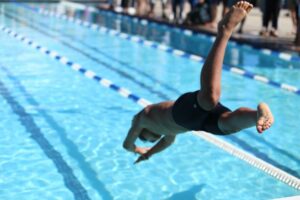Butterfly swimming is not just a stroke; it’s an art form that combines power, grace, and technique. While the traditional butterfly stroke is well-known, swimmers around the world are constantly pushing the boundaries, experimenting with innovative styles that not only enhance performance but also captivate spectators. In this article, we’ll explore some of the groundbreaking butterfly swimming styles that go beyond the basics, offering a glimpse into the evolving world of competitive swimming.
The Undulating Dolphin Kick
One of the most revolutionary techniques in butterfly swimming is the incorporation of the undulating dolphin kick. Traditionally, swimmers execute a powerful up-and-down leg movement, but the undulating dolphin kick takes it to a whole new level. This style involves a continuous, wave-like motion of the legs, resembling the movement of a dolphin. By mastering this technique, swimmers reduce drag and achieve a smoother, more streamlined glide through the water.
To perfect the undulating dolphin kick, swimmers focus on flexibility and core strength. Stretching exercises that enhance the range of motion in the hips and ankles become crucial. Additionally, a strong core enables swimmers to maintain control over the undulating motion, making it a vital component in mastering this innovative butterfly style.

The Hybrid Butterfly-Backstroke
Blurring the lines between traditional butterfly and backstroke, the hybrid butterfly-backstroke is gaining popularity among swimmers seeking a competitive edge. In this style, swimmers combine the powerful arm movements of the butterfly stroke with the more relaxed and rhythmic leg kicks of the backstroke. The result is a fluid and efficient stroke that minimizes energy expenditure while maximizing speed.
To execute the hybrid butterfly-backstroke effectively, swimmers need to master the coordination between their arms and legs. This involves precise timing to ensure that the arm movements and leg kicks complement each other, creating a harmonious and propulsive motion. The hybrid butterfly-backstroke challenges swimmers to find the perfect balance between power and finesse, making it a style that demands both skill and creativity.
The Three-Stage Butterfly
Breaking down the traditional butterfly stroke into three distinct stages, this innovative style allows swimmers to optimize their efficiency and speed. The first stage focuses on a powerful arm pull, propelling the swimmer forward with maximum force. The second stage emphasizes a streamlined body position, minimizing drag and maintaining momentum. The final stage involves a quick and explosive dolphin kick, providing an additional burst of speed.
Mastering the three-stage butterfly requires a deep understanding of each component and the ability to seamlessly transition between them. Swimmers must develop strength in their arms for the powerful pull, work on their body position to reduce resistance, and refine their dolphin kick for maximum propulsion. The three-stage butterfly is a strategic approach to the traditional stroke, offering swimmers a nuanced and dynamic way to navigate the water.
The Hypoxic Butterfly
Taking inspiration from high-altitude training, the hypoxic butterfly focuses on controlled breath-holding to improve lung capacity and overall swimming endurance. Swimmers practicing this style intentionally limit their breathing, increasing the challenge and intensity of the butterfly stroke. While it may seem counterintuitive, the hypoxic butterfly has been shown to enhance respiratory efficiency and stamina.
To incorporate the hypoxic butterfly into training, swimmers gradually increase the duration of breath-holding during practice sessions. This style not only improves lung capacity but also forces swimmers to maintain proper form and technique even when oxygen-deprived. The result is a more resilient and conditioned athlete, ready to conquer longer distances with ease.

The Butterfly Flip-Turn
A game-changer in competitive swimming, the butterfly flip-turn seamlessly combines the power of the butterfly stroke with the efficiency of the flip-turn used in freestyle and backstroke events. Instead of executing a traditional open turn, swimmers performing the butterfly flip-turn execute a quick somersault, allowing for a faster and more streamlined transition at the pool wall.
To master the butterfly flip-turn, swimmers must perfect the timing of the somersault to avoid losing momentum. Additionally, strong core muscles play a crucial role in executing a tight and controlled flip. The butterfly flip-turn not only shaves valuable seconds off race times but also adds a dynamic element to the traditional butterfly stroke.
Conclusion
The world of butterfly swimming is continuously evolving, with athletes and coaches exploring new techniques to gain a competitive edge. From the undulating dolphin kick to the hybrid butterfly-backstroke, these innovative styles showcase the creativity and adaptability of swimmers in their quest for excellence. Whether it’s improving efficiency, increasing speed, or enhancing endurance, these styles go beyond the basics, pushing the boundaries of what is possible in butterfly swimming. As the sport continues to progress, we can only anticipate even more groundbreaking styles that will redefine the future of competitive butterfly swimming.
AUTHOR
Sang Nguyen
Sang Nguyen is a former national swimmer for Vietnam who has transitioned into coaching. With a passion for fostering a healthy swimming community and connecting like-minded individuals,......Read More
BLOG
Maybe You Are Interested
Butterfly Arm Stroke Movement
The butterfly stroke, with its captivating undulations and powerful movements, requires a refined butterfly arm...
2 Butterfly Kick Swimming Drills: Building Power from the Core
The butterfly stroke, known for its powerful undulations and graceful movements, relies heavily on a...
5 Ways to Improve Your Butterfly Swim Technique
The butterfly stroke, also known as the fly swimming technique, is a captivating display of...
8 Butterfly Stroke Tips to Help You Improve Your Skill
The butterfly stroke, also known as the butterfly swim, is undeniably one of the most...
Discover Information About Butterfly Stroke: From History to Technique and Benefits
The butterfly stroke, also known as butterfly swim or fly swim stroke, is one of...
Competitive Swimmer Diet in Olympics: Fueling Your Gold Medal Dreams
Competitive swimmers push their bodies to the limit, demanding a competitive swimmer diet that provides...